Census 2010: Children = Diversity
With each new release from the 2010 Census, the details of Indiana's recent demographic shifts come into focus. In December 2010, we learned that the state added 400,000 new residents since 2000 to reach a total population of 6.48 million. This 6.6 percent growth rate far outpaced neighboring Illinois, Ohio and Michigan, yet was below the U.S. mark of 9.7 percent.
A subsequent data release showed that Indiana's population grew unevenly in terms of geography, race and ethnicity. The 10-county Indianapolis-Carmel metro area, for instance, accounted for nearly 60 percent of the state's total growth while many of the mid-sized communities that long formed much of Indiana's industrial backbone saw significant population decline. This is particularly the case through a large swath of north-central and east-central Indiana.
As for race and ethnicity, the state added more Hispanic residents (175,200) and black residents (76,700) than non-Hispanic whites (67,100). As a result, the non-Hispanic white population's share of the Indiana total dropped from 85.8 percent in 2000 to 81.5 percent in 2010.
The May 2011 release of Indiana's demographic profile sheds light on another key trend: Indiana is growing older.
This article will focus on Indiana's increasing diversity and its aging population. In particular, we will examine how the baby boom generation is leading to a "graying" of the population both in Indiana and nationally. We will also look at how minority populations are driving growth in Indiana's younger age groups. These trends promise to transform Indiana's population in the coming decades. So, while the data presented here look back over the last 10 years, they also offer a glimpse of Indiana's future.
Growing Older
Between 2000 and 2010, Indiana's median age jumped from 35.2 to 37.0. Despite this increase, the state remains comparatively young (see Figure 1). Indiana's 2010 median age is a shade higher than neighboring Illinois but is roughly two years younger than Michigan and Ohio and one year below the Kentucky mark. Indiana is also younger than the U.S. median age, which increased from 35.3 years in 2000 to 37.2 in 2010.
Figure 1: Median Age by State, 2010
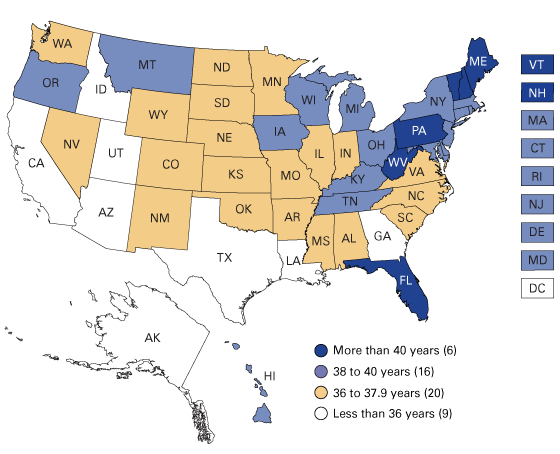
Source: IBRC, using Census Bureau data
Indiana's median age masks stark differences within the state. Many rural or mid-sized communities are aging rapidly while a few metropolitan areas remain relatively young as they attract young adults and families. Nearly two-thirds of Indiana counties have a median age above 39, led by Brown (46.7), Ohio (43.7), Pike (42.8), and Tipton (42.6) counties. At the other end of the spectrum, only 14 counties had a median age below the Indiana mark. Aside from communities with sizeable college student or Amish populations, the state's youngest counties are also some of its largest, including Marion (33.9), Elkhart (34.9), Allen (35.3), Hamilton (35.6) and Hendricks (36.7) counties. Regardless of whether they are relatively young or old, each county saw its median age increase over the decade with the exception of Daviess County.
The baby boom generation accounts for much of this aging trend. The number of Hoosiers between the ages of 45 and 64 (a grouping that contained all boomers in 2010) increased by 27 percent over the decade (see Figure 2). All Indiana counties saw an increase in this age group.
Figure 2: Percent Change in Indiana Population by Age Group, 2000-2010
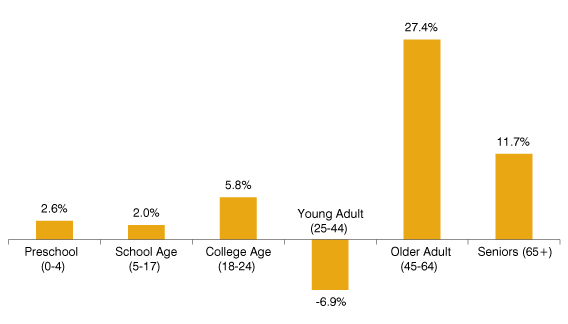
Source: IBRC, using Census Bureau data
Meanwhile, the state's young adult population (ages 25 to 44) declined 6.9 percent as boomers vacated this age group. Only 10 Indiana counties saw their young adult population grow in the past decade.
A decline in this age group is not unique to Indiana. Every state in the Northeast and the Midwest experienced a drop in its young adult population between 2000 and 2010. But in the South and the West, only Kentucky, West Virginia, Louisiana, Mississippi, Alabama and Montana saw this age group shrink.
More Children
Indiana bucked the broader regional trend by having an increase in the number of children (ages 0 to 17) in the state compared to Census 2000. The child population declined in every state in the Northeast and Midwest with the exception of Indiana, South Dakota, Nebraska and Kansas.
Although Indiana's child population increased between 2000 and 2010, much of this growth was concentrated in a handful of large metropolitan areas, college communities and counties with large Amish populations (see Figure 3). In all, 68 of Indiana's 92 counties saw their child population decline over the decade. This age group fell by 5 percent or more in 45 of these counties.
Figure 3: Percent Change in the Population Under Age 18 by County, 2010
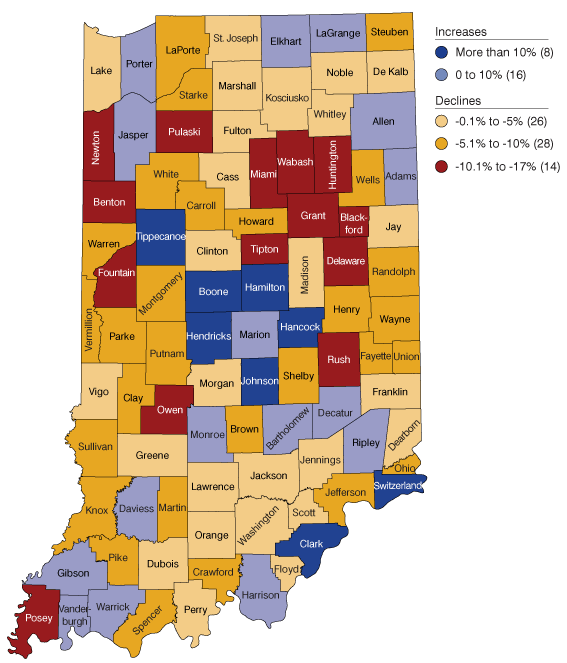
Source: IBRC, using Census Bureau data
Greater Diversity among Children
The nature of the growth within the state's child population underscores Indiana's growing racial and ethnic diversity.
Indiana's child population grew over the decade despite a 7.5 percent drop in the number of non-Hispanic white children. This rate of decline equates to 95,700 fewer non-Hispanic white children in 2010 (see Figure 4). However, the number of Hispanic children more than doubled over the same period and the multi-race and Asian child populations jumped by nearly 90 percent.
Figure 4: Change in Child Population Under 18 by Race and Ethnicity, 2000-2010
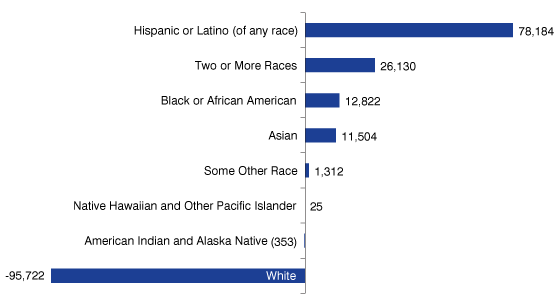
Note: Hispanic or Latino is an ethnicity not a race. Figures for race groups exclude Hispanic residents of that race.
Source: IBRC, using Census Bureau data
The number of black children in the state grew by 8 percent. All told, the state's minority child population increased by 129,600 between 2000 and 2010.
Because of its strong growth in the younger age groups, Hispanic residents now account for 9.6 percent of the total Indiana child population compared to 4.8 percent of the state's population age 18 or older (see Figure 5). By contrast, non-Hispanic white residents make up 73.9 percent of the state's population under 18 compared to 84 percent of the adult population. Indiana's black residents account for 10.9 percent of the child population and 8.3 percent of the adult population.
Figure 5: Share of Indiana Population by Age Group, Race and Ethnicity, 2010
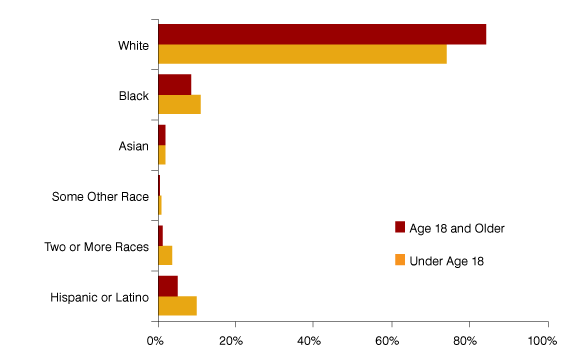
Note: Hispanic or Latino is an ethnicity not a race. Figures for race groups exclude Hispanic residents of that race.
Source: IBRC, using Census Bureau data
The same trend is playing out across the country. Non-Hispanic whites make up 67 percent of the U.S. population over age 18 yet account for just 54 percent of the total child population. Meanwhile, the Hispanic share of the U.S. population jumps from 14 percent of all adults to 23 percent of children.
Learn More
The Census Bureau provides detailed demographic profiles down to the city/town and township levels. Complete data can be found at the American FactFinder website. The bureau will release data with greater age, sex, race and ethnicity detail later this summer. Visit STATS Indiana for easily accessible data extracts and more: http://www.stats.indiana.edu/topic/census.asp.
Matt Kinghorn
Demographer, Indiana Business Research Center, Indiana University Kelley School of Business
